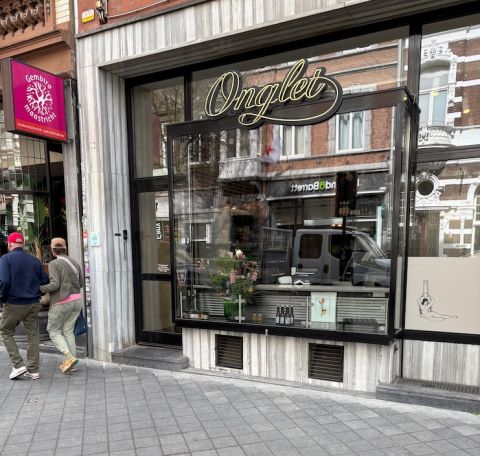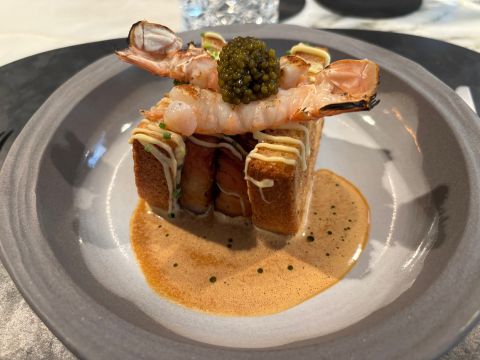The sound of sabayon being made is unique: the clack of a whisk against metal as the eggs are beaten. But how many restaurant-goers have ever heard it? Not many, I would guess.
When this dish was popular, and relatively common on dessert menus, all professional kitchens were behind swing doors and this warm, airy, egg-based, sweet sauce appeared only when it was ready, usually served in a smart glass or a small bowl. By the time open kitchens were prevalent, the dish seemed to have long been forgotten.
Perhaps this is because it requires the attention of one dedicated chef to beat the ingredients à la minute. But during a recent stay in Maastricht (pictured above, and divided by the river Maas/Meuse) in the Netherlands close to the border with Belgium, I saw it on the dessert menu of Harry’s, the smart restaurant that is part of the Hotel Beaumont. The final item on the dessert menu was described as ‘sorbet & sabayon for two, served with pear, vanilla and almond.’
This rich mixture of egg yolks, sugar, wine and air is a little more common in Italy where, as zabaglione, it typically incorporates Marsala, but in northern Europe, in my experience, it has virtually disappeared. But towards the end of our dinner at Harry’s with its open kitchen, I suddenly heard the unmistakable sound of a sabayon being made, which inspired us to order one for ourselves. It did not disappoint, although the creamy, rich, warm liquid would have been even better without the cool sorbet.
All our dishes came from what looked like an enormous open kitchen. There was Big Frank, chef Frank van Thiel, on the left, and the pass on the right, with a great deal of activity in between – even when cooking my scrambled eggs the following morning.
This and the larger bedrooms and public rooms throughout the hotel are the result of a few years of hard work by Jean-Marc Beaumont and his younger brother, Christophe, who, after several years in the US, Australia and Singapore, moved back into their family hotel that had been founded four generations ago, in 1912.
They reduced the number of bedrooms; changed a nearby annexe into The Dutch, a self-service hotel; and made a feature of Harry’s, their restaurant on a magnificent corner site. As Beaumont explained, ‘A hotelier today has to know which kind of customer he wants to attract as well as all that their customers will want once they have settled into their room.’
What many hotel customers want today is a lively restaurant, which Harry’s confidently is, its confidence obvious from its easy-to-read menu. It begins with a brief description of their three-hectare farm nearby and all that its farmer, Reinier Hoon, provides, including the ingredients that lead to a brioche topped with chicken livers and a pizzetta with mushrooms, lardo and pine nuts (shown below). Main courses included half a lobster with orzo and nduja; skrei, Norwegian cod that migrates from the Barents Sea in the spring, with Jerusalem artichokes; and for the three of us a skate wing covered in capers that it was my pleasure to carve and serve. Chips were also provided with an elegant mayonnaise.
We drank well, too. We began with a bottle of 2020 La Falize, an organic Chardonnay grown on a newish estate in the Namur province in central Belgium. It’s made by Peter Colemont and, like Colemont’s own Clos d’Opleeuw, showed the potential of Belgian Chardonnay. We followed this with a bottle of unusually smooth Bocale Sagrantino 2019 Montefalco in honour of Jean-Marc Beaumont's Umbrian father-in-law which delighted all those who had ordered fish. The bill for the five of us came to just under €600 of which the wines were €200.
It seems fitting that in such a historic city as Maastricht, my bill at the second restaurant I visited should be contained in a folder from a bill for meat dated November 1915.
The location was the Onglet restaurant which for 120 years had been home to Schürmann’s butchery. Six years ago, with retail sales of meat falling substantially, the proprietor decided to lease the building. Step forward Levy Smit, once trained in the Maastricht hospitality school opened by Jean-Marc Beaumont’s grandfather, someone who was keen to provide a new future for this early 20th century butcher’s shop.
I met Smit on the evening after I had eaten in his restaurant. He struck me as an extremely confident restaurateur, as befits a man who has chosen a distinctive path for his restaurant. Tall, fit – about to run the Rotterdam marathon – he spoke unerringly about what he has inherited and its future.
‘The entrance is as it has always been, through the shop which we continue to operate on a Thursday, Friday and Saturday. So we have to keep the front door locked at all other times to stop pilferage. And once you have walked through the passageway with the glass-fronted meat hanging space, you are into an area that was once full of the cold storage fridges, the offices and the packing cases for the retail butchery. We’ve converted all this into our restaurant.’
Inside the restaurant are two open kitchens at 90 degrees to each other which also provide counter seating.
The menu is very meat-focused which is a policy that Smit explained is in keeping with the building’s past. ‘We do have fish on the menu occasionally’, he said defensively. ‘For instance during TEFAF.’ This important annual antique and art fair takes place in mid March and brings vast crowds to Maastricht. Onglet is closed on Wednesdays but is also, more unexpectedly, closed on Saturdays (‘it means a lot to the staff’, Smit quipped) but is open for Sunday lunch and dinner.
The menu, as I explained to Smit, is somewhat confusing perhaps because it expects every customer to be hungry enough for their seven-course menu which takes the customer through many cuts of various animals. It begins with onglet, segues through a brioche filled with ox sausage, beef blade and ends with a veal escalope in a sauce of ceps, all this for a price of €149 for two.
Since I knew I would be facing a five-course dinner less than five hours after my lunch, I asked to be excused from this long menu, which the waitress accepted immediately, and chose instead a dish of brioche, topped with pork belly, caviar and langoustines (above) as a rich and obviously well executed first course. And then, with some assistance from the waitress, I chose an equally convincing dish of beef blade with an eel beurre blanc (below). This was absolutely terrific and, with a glass of 2018 Cabernet Sauvignon from Loranque in Spain (€9), my final bill presented in that charming folder was €71.50.
Maastricht is primarily known for TEFAF and for the 1992 treaty that paved the way for European integration. But in the sunshine over the weekend I found far more to enjoy: charming small streets; a great deal of history; more opticians’ shops than I ever thought possible in a single city, and two distinctive and highly memorable restaurants.
Harry’s Wycker Brugstraat 2, 6221 Maastricht, The Netherlands; tel: +31 43 3281366
Onglet Wycker Brugstraat 27, 6221 Maastricht, The Netherlands; tel: +31 43 8528847
Photo of the riverside in Maastricht by Bo Ummels on Unsplash.
Every Sunday, Nick writes about restaurants. To stay abreast of his reviews, sign up for our weekly newsletter.























